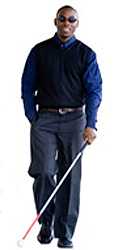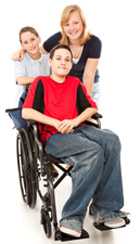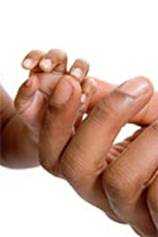People with Disabilities

Since the Americans with Disabilities Act was enacted in 1990, many social barriers have been removed or reduced for people with disabilities. But there is more work that needs to be done for people with disabilities to become more independent and involved in their world. Good health is important to be able to work, learn, and be engaged within a community.
This web page provides information for people with disabilities about healthy living, safety, school, transitions, independent living, and finding support.
Healthy Living
People with disabilities need health care and health programs for the same reasons anyone else does—to stay well, active, and a part of the community.
Having a disability does not mean a person is not healthy or that he or she cannot be healthy. Being healthy means the same thing for all of us—getting and staying well so we can lead full, active lives. That means having the tools and information to make healthy choices and knowing how to prevent illness.
Learn more about healthy living »
Safety
People with disabilities can be at higher risk for injuries and abuse. It is important for parents and other family members to teach their loved one how to stay safe and what to do if they feel threatened or have been hurt in any way.
For more information:
Bullying and Children and Youth with Disabilities and Special Health Needs
Assistive Technology
Assistive technologies (AT) are devices or equipment that can be used to help a person with a disability fully engage in life activities. AT’s can help enhance functional independence and make daily living tasks easier through the use of aids that help a person travel, communicate with others, learn, work, and participate in social and recreational activities. An example of an assistive technology can be anything from a low-tech device, such as a magnifying glass, to a high tech device, such as a special computer that talks and helps someone communicate. Other examples are wheelchairs, walkers, and scooters, which are mobility aids that can be used by persons with physical disabilities.
For more information:
Publications, Organizations, and Programs: People with Disabilities and Assistive Technology

School
In order to help a child fully participate in school, plans can be developed around the child’s specific needs. These plans, known as 504 plans, are used by general education students not eligible for special education services. By law, children may be eligible to have a 504 plan which lists accommodations related to a child’s disability. The 504 plan accommodations may be needed to give the child an opportunity to perform at the same level as their peers. For example, a 504 plan may include your child’s assistive technology needs, such as a tape recorder or keyboard for taking notes and a wheelchair accessible environment.
A different plan is needed for children taking special education classes. An Individual Education Plan (IEP) is a legal document that tells the school its duties to your child.
For more information:
A Parent’s Guide to Section 504 in Public Schools
IEP Plan: Information for Parents
Transitions
For some people with disabilities and their parents, change can be difficult. Planning ahead of time may make transitions easier for everyone.
A Personal Story
When Jim was 3 months old, his mother was told he had cystic fibrosis. His doctor asked Jim’s mother where she wanted Jim to be in 20 years. Looking ahead, she told the doctor she wanted Jim to go to college. Working as a team, Jim’s doctor and mother began to plan for his future. Jim learned early that he needed to be involved in his own health care. With support from family, school, and health care professionals, Jim took on more and more responsibility for his own health. He also learned to take care of himself by exercising, eating right, and avoiding alcohol and tobacco.
Today, Jim is 24, married, working, and buying a home. He believes he has been able to enjoy a full life, in spite of his disability.
Transitions occur at many stages of life. For example, the transition from teen years to adulthood can be especially challenging. There are many important decisions to make, such as deciding whether to go to college, a vocational school, or enter the workforce. It is important to begin thinking about this transition in childhood, so that educational transition plans are put in place. Ideally, transition plans from teen years to adulthood are in place by age 14, but no later than age 16. This makes sure the person has the skills he or she needs to begin the next phase of life. This stage in life also involves transitioning one’s health care services from pediatricians to physicians who primarily treat adults.
For more information:
Independent Living
Independent living means that a person lives in his or her own apartment or house and needs limited or no help from outside agencies. The person may not need any assistance or might need help with only complex issues such as managing money, rather than day-to-day living skills. Whether an adult with disabilities continues to live at home or moves out into the community depends in large part on his or her ability to manage everyday tasks with little or no help. For example, can the person clean the house, cook, shop, and pay bills? Is he or she able to use public transportation? Many families prefer to start with some supported living arrangements and move towards increased independence.
For more information:
A Center for Independent Living
Build or Modify Your Home for Independence
U.S. Department of Housing and Urban Development: Information for People with Disabilities
Finding Support

For many people with disabilities and those who care for them, daily life may not be easy. Disabilities affect the entire family. Meeting the complex needs of a person with a disability can put families under a great deal of stress — emotional, financial, and sometimes even physical.
However, finding resources, knowing what to expect, and planning for the future can greatly improve overall quality of life. If you have a disability or care for someone who does, it might be helpful to talk with other people who can relate to your experience.
Find a Support Network
By finding support within your community, you can learn more about resources available to meet the needs of families and people with disabilities. This can help increase confidence, enhance quality of life, and assist in meeting the needs of family members.
A national organization that focuses on the disability, such as Spina Bifida Association, that has a state or local branch, such as Spina Bifida Association in your state, might exist. State or local area Centers for Independent Living could also be helpful. United Way offices may be able to point out resources. Look in the phone book or on the web for phone numbers and addresses.
Other ways to connect with other people include camps, organized activities, and sports for people with disabilities. In addition, there are online support groups and networks for people with many different types of disabilities.
Talk with a Mental Health Professional
Psychologists, social workers, and counselors can help you deal with the challenges of living with or caring for someone with a disability. Talk to your primary care physician for a referral.
More Information
For information on topics not mentioned here, try the following websites.
GovBenefits.gov
GovBenefits.gov, a partnership of federal agencies, provides improved, personalized access to government assistance programs. This website can help people with disabilities and their families determine if there are government benefits they can receive.
- Page last reviewed: August 3, 2017
- Page last updated: August 3, 2017
- Content source:




 ShareCompartir
ShareCompartir